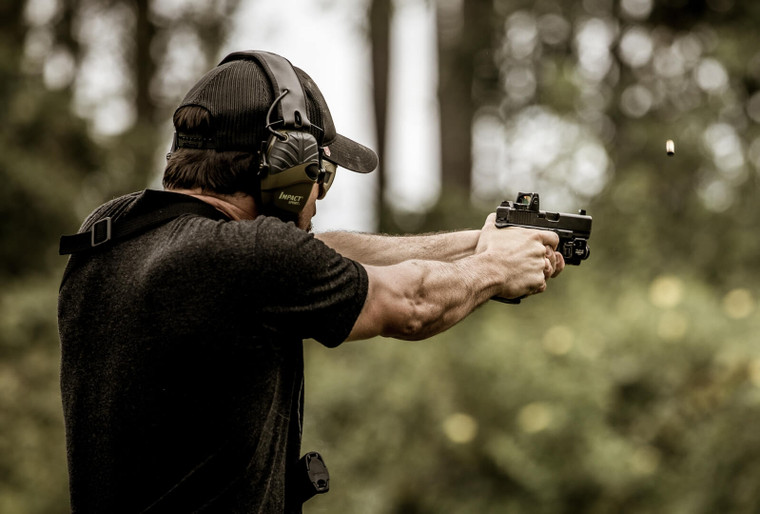Do You Really Need to Use Your Sights?
Posted by Warrior Poet Society on Oct 17th 2025
When it comes to defensive shooting, one of the most common questions we hear is: At what distance do you actually need a solid sight picture?
This isn’t just theory. It could mean the difference between winning or losing in a real fight. If you’re at arm’s length from a threat, taking time to get a perfect sight picture might cost you precious milliseconds, but if you’re back at 12 yards, point shooting alone could result in devastating misses, not only missing your target but potentially harming an innocent bystander.
To put this question to the test, Paul and I (John) decided to run a friendly competition.
The setup was simple:
• Targets: IPSC silhouettes
• Scoring: A-zone only
• Rules: Always present the gun to full extension before shooting. No retention shots
• Conditions: Paul’s gun had no sights at all, forcing him to rely on pure point shooting, while I committed to using my sights every time (whether a quick flash or a precise alignment).
Let’s break down what happened.
Point-Blank Range: Speed Wins
At arm’s reach, Paul blazed ahead with his sightless gun. His hits landed clean in the A-zone, and my carefully confirmed sights only slowed me down by a quarter second or so.
At this distance, sights didn’t help. In fact, they hurt. Point shooting worked perfectly, and milliseconds mattered.
Takeaway: Within 2 yards, trust your body index and get the gun out fast.
2–3 Yards: Still Close, But Accuracy Shifts
As we stepped back a bit, Paul’s raw speed kept him in the lead, but his accuracy started falter. My sight-focused shots stayed consistently tight in the A-zone (even if only just slightly slower).
At this middle distance, the tradeoff began to show: if you have the skill, speed can land you on target, but over time accuracy wins the fight.
Takeaway: At 2–3 yards, point shooting still works, but now sights start to matter, especially if precision is required (like a headshot).
5–6 Yards: The Balance Point
This is where things got interesting. Paul was still faster, but his hits were less reliable. My careful sight confirmation kept my shots grouped tightly in the A-zone.
At this distance, the edge started tilting toward sights. Sure, a fast first hit might win the fight, but misses or peripheral hits could cost you.
Takeaway: At 5–6 yards, it’s smarter to confirm your sights—even briefly—before breaking the shot.
12 Yards: The Limits of Point Shooting
At longer range, Paul’s “sightless” shooting finally failed. His first attempts landed nowhere near the A-zone, while my slower, deliberate shots stacked clean hits.
After another round, Paul did manage a lucky A-zone, but the lesson was clear: beyond 10 yards, ignoring your sights is a recipe for misses. Keep in mind that Paul is a highly-trained marksmen with combat experience.
Takeaway: At 12 yards, proper sight picture is non-negotiable.
The Bigger Lesson
This wasn’t just a competition, it was a learning experiment. The truth is:
• At point-blank range (0–2 yards): Don’t waste time with sights. Go fast.
• At close range (3–5 yards): Point shooting can work, but sights begin to matter. If you’re not trained to have consistent grip and presentation, you’ll fail at this range.
• At mid-range (6–10 yards): You need your sights, unless you’ve got serious marksmanship skills.
• At distance (10+ yards): Use your sights, every time, even if you’re a pro.
Ultimately, it comes down to knowing your own skill level. Paul can point shoot well because he’s logged thousands of repetitions using sights in training. Most shooters without that background won’t have the same consistency.
Milliseconds matter. But so does accuracy. The key is training enough that you intuitively know how much sight confirmation is required—based on distance and context—without having to think about it.
Final Thoughts
At the end of the day, this wasn’t about who “won.” The real point is this: know your distances, know your skill level, and train for both speed and accuracy.
If you want to go deeper, come train with us at Warrior Poet Society.
Remember, Train Hard. Train Smart. And practice that perfect draw and presentation.

